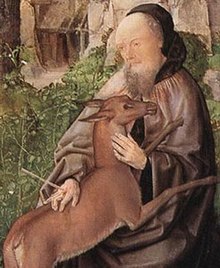Giles | |
|---|---|
 Detail of Saint Giles and the Hind, by the Master of Saint Giles c. 1500 | |
| Abbot, Hermit | |
| Born | c. 650[1] Athens, Achaea, Eastern Roman Empire |
| Died | c. 710 (aged c. 60)[1] Septimania, Visigothic Kingdom (Languedoc, Southern France) |
| Venerated in | Roman Catholic Church Eastern Orthodox Church Anglican Communion |
| Canonized | Pre-Congregation |
| Major shrine | Abbey of Saint-Gilles (Saint-Gilles, France) St. Giles' Cathedral (Edinburgh, Scotland) |
| Feast | 1 September |
| Attributes | arrow; crosier; hermitage; hind |
| Patronage | beggars; blacksmiths; breast cancer; breast feeding; cancer patients; disabled people; Edinburgh (Scotland); epilepsy; noctiphobics; forests; hermits; horses; lepers; mental illness; outcasts; poor people; rams; spur makers; sterility |
Saint Giles (/dʒaɪlz/, Latin: Aegidius, French: Gilles, Italian: Egidio, Spanish: Gil; c. 650 - c. 710), also known as Giles the Hermit, was a hermit or monk active in the lower Rhône most likely in the 7th century. Revered as a saint, his cult became widely diffused but his hagiography is mostly legendary. A town that bears his name grew up around the monastery he purportedly founded, which became a pilgrimage centre and a stop on the Way of Saint James. He is traditionally one of the Fourteen Holy Helpers.
- ^ a b "The West Portal of Saint-Gilles-du-Gard," Archived 2006-09-27 at the Wayback Machine by R. J. Gangewere, Carnegie Museums of Pittsburgh, September/October 2003.